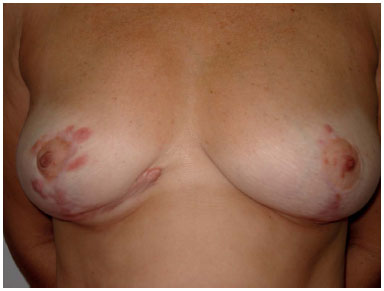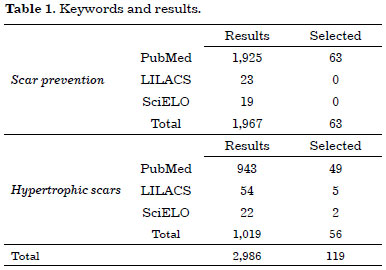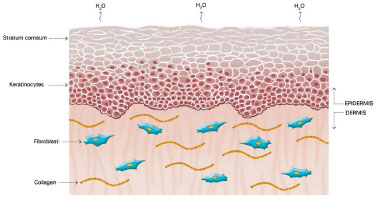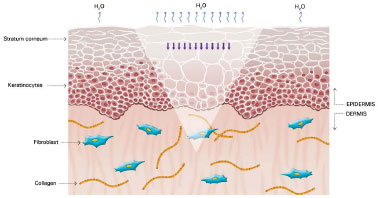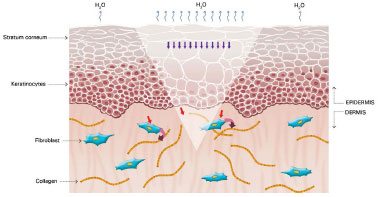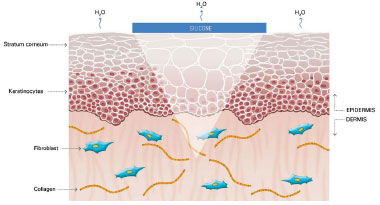ABSTRACT
INTRODUCTION: Considering that nearly 51 million surgeries are performed annually just in the USA, we can state that scar hypertrophy is a relevant problem, since a thin, good quality scar can be the dividing line between a good outcome and an unsuccessful surgery. The objective is to perform a bibliographic review of the noninvasive methods currently available to prevent postoperative hypertrophic scars and discuss their evidence-based effectiveness.
METHOD: A search was performed in PubMed, LILACS, and SciELO databases, using the terms "scar prevention" and "hypertrophic scars," for clinical trials, meta-analyses, and review articles published since 2004 in English or Portuguese language.
RESULTS AND CONCLUSIONS: Several studies using silicone were found, providing some evidence on its effectiveness; only 3 prospective clinical trials using Contractubex® were found; 2 controlled, randomized prospective clinical trials using 5% imiquimod were found, but only one was double-blind; one well-designed clinical trial using a micropore adhesive tape was found; a similar clinical trial using vitamin E did not show good results. Clinical trials on the use of massage and local pressure were not found. Despite the limitations of the studies, silicone is considered the first treatment option for the prevention of postoperative hypertrophic scars. There is no evidence proving the effectiveness of micropore adhesive tape, massage, local pressure, Contractubex, 5% imiquimod, or vitamin E.
Keywords:
Hypertrophic scar; Hypertrophic scar/Prevention & Control; Cicatrization; Silicone; Vitamin E.
RESUMO
INTRODUÇÃO: Considerando um número estimado de cerca de 51 milhões de cirurgias a cada ano apenas nos EUA, podemos dizer que a hipertrofia cicatricial é um problema relevante, já que uma cicatriz fina, de boa qualidade, pode ser a linha divisória entre um bom resultado e uma cirurgia malsucedida. O objetivo é fazer uma revisão bibliográfica acerca dos métodos de tratamento não invasivos atualmente disponíveis para a prevenção da hipertrofia cicatricial pós-cirúrgica e discutir a sua eficácia baseada em evidências.
MÉTODO: Foi realizada uma pesquisa nas bases de dados Pubmed, Lilacs e SciELO, utilizando os termos "scar prevention" and "hypertrophic scars", por ensaios clínicos, meta-análises e artigos de revisão publicados a partir de 2004, em inglês ou português.
RESULTADOS E CONCLUSÕES: Foram encontrados vários trabalhos utilizando o silicone, proporcionando alguma evidência acerca da sua eficácia; foram encontrados apenas três ensaios clínicos prospectivos relacionados ao uso do Contractubex®; dois ensaios clínicos prospectivos, controlados, randomizados, sendo apenas um deles duplo-cego, com o imiquimode a 5%; foi encontrado apenas um ensaio clínico bem desenhado utilizando o esparadrapo microporoso e outro trabalho relacionado ao uso da vitamina E, que não mostrou bons resultados; não foram encontrados ensaios clínicos sobre o uso da massagem e da pressão local. Apesar das deficiências dos estudos, o silicone é considerado a primeira opção na prevenção da hipertrofia cicatricial pós-cirúrgica. Não há evidências que comprovem a eficácia do esparadrapo microporoso, da massagem, da pressão local, do Contractubex, do imiquimode a 5% e da vitamina E.
Palavras-chave:
Cicatriz hipertrófica; Cicatriz hipertrófica/Prevenção & Controle; Cicatrização; Silicones; Vitamina E.


